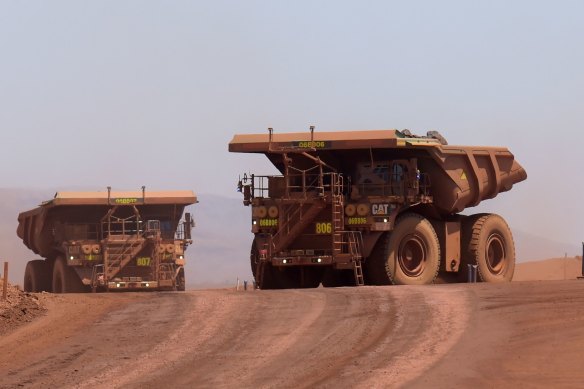By Nick Toscano
Rio Tinto, one of the largest Australian miners, has flagged it is open to potentially large-scale takeover opportunities to boost its supplies of copper and capitalise on expectations of soaring demand for the metal in the global energy transition.
The resources giant, which earns most of its money from digging up the steel-making ingredient iron ore in Western Australia and selling it to China, on Wednesday said it was aiming to grow annual copper production over the next five years from existing projects, including its jointly owned Oyu Tolgoi development in Mongolia’s Gobi Desert.

Rio has posted $US5.8 billion net profit for the half-year as iron ore prices start trending down.Credit: Bloomberg
Rio Tinto chief executive Jakob Stausholm also confirmed that the Anglo-Australian miner was constantly the lookout for other opportunities through which its exposure to the red metal could “grow further”.
“We are the world’s largest producer of iron ore, we are the Western world’s largest producer of aluminum, we are the world’s largest producer of titanium slag, and we are only the top-five [or] top-10 producer of copper,” Stausholm said.
“You can see that as a negative. I see it as a positive. It’s an area where we can grow and where we are growing.”
Rio Tinto was cautious about buying into a “heated market”, Stausholm said, as major mining groups in Australia and around the world raced to lock in greater supplies of the red metal.
“While we are looking we are sometimes saying ‘we are not prepared to pay those prices’,” he said.
As a key ingredient to build electrical wiring, copper will be needed in vastly greater quantities in the build-out of renewable generation and transmission projects, while electric cars require up to four times more copper than internal combustion engine vehicles.
Melbourne-based BHP, the world’s largest mining company, this year made repeated attempts to buy London-listed heavyweight Anglo American, which it had targeted largely for its huge copper mines in South America. BHP walked away from the proposal after its final $US49 billion ($75 billion) offer was rejected as too low.
BHP this week agreed to spend $US2.1 billion ($3.2 billion) to grow its South American copper business under a deal with Canada’s Lundin Mining to acquire a 50 per cent stake in junior copper miner Filo Corp.
Stausholm’s comments on copper came as Rio Tinto reported company-wide underlying earnings of $US5.8 billion ($8.9 billion) in the six months to June 30, up 1.8 per cent from the year earlier. The result narrowly missed most analysts’ estimates.
The board declared an interim dividend of $US1.77 per share, which was below consensus estimates of $US1.81.
“While minor, the miss on the dividend will likely be the focus,” said Kaan Peker, an analyst with the Royal Bank of Canada.
Rio Tinto said it was also pressing on with efforts to bring its massive Simandou iron ore joint venture in Africa’s Guinea into production by next year.

Jakob Stausholm, chief executive officer of Rio Tinto.Credit: Bloomberg
The Rio Tinto-backed Simandou project is believed to have some of the world’s richest iron ore deposits, but its development has been delayed for years amid disputes over infrastructure funding and various interventions from Guinea’s military junta, which seized power in a coup in 2021.
Iron ore, the key material needed to manufacture steel, is Australia’s most valuable export, and is expected to rake in more than $130 billion in revenue this financial year alone.
However, analysts predict Guinea’s Simandou region may one day rival the iron ore volumes of WA’s iron ore-rich Pilbara region, while China is increasingly looking to Simandou as a way to lessen its reliance on Australian supplies.
Sausholm on Wednesday said Rio Tinto’s half-year results demonstrated the business was “consistently very profitable and growing”.
“This is being driven by the disciplined investments we are making to strengthen our operations and progress major projects for profitable organic growth,” he said.
The Business Briefing newsletter delivers major stories, exclusive coverage and expert opinion. Sign up to get it every weekday morning.